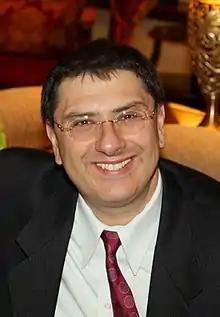Rafail Ostrovsky
Rafail Ostrovsky is a distinguished professor of computer science and mathematics at UCLA and a well-known researcher in algorithms and cryptography.
Rafail Ostrovsky | |
|---|---|
 | |
| Born | 1963 (age 60–61) |
| Nationality | American |
| Alma mater | MIT |
| Scientific career | |
| Fields | Algorithms and cryptography |
| Institutions | UCLA |
| Thesis | Software Protection and Simulation on Oblivious RAMs (1992) |
| Doctoral advisor | Silvio Micali |
| Doctoral students |
|
| Website | www |
Biography
Rafail Ostrovsky received his Ph.D. from MIT in 1992.
He is a member of the editorial board of Algorithmica , Editorial Board of Journal of Cryptology and Editorial and Advisory Board of the International Journal of Information and Computer Security .
Awards
- 2022 W. Wallace McDowell Award[1] "for visionary contributions to computer security theory and practice, including foreseeing new cloud vulnerabilities and then pioneering corresponding novel solutions"
- 2021 AAAS Fellow[2]
- 2021 Fellow of the Association for Computing Machinery[3] "for contributions to the foundations of cryptography"
- 2019 Academia Europaea Foreign Member [4]
- 2018 RSA Award for Excellence in Mathematics "for contributions to the theory and to new variants of secure multi-party computations"
- 2017 IEEE Edward J. McCluskey Technical Achievement Award [5] "for outstanding contributions to cryptographic protocols and systems, enhancing the scope of cryptographic applications and of assured cryptographic security."
- 2017 IEEE Fellow,[6] "for contributions to cryptography”
- 2013 IACR Fellow "for numerous contributions to the scientific foundations of cryptography and for sustained educational leadership in cryptography" [7]
- 1993 Henry Taub Prize
Publications
Some of Ostrovsky's contributions to computer science include:
- 1990 Introduced (with R. Venkatesan and M. Yung) the notion ofhttps://services27.ieee.org/fellowsdirectory/home.html interactive hashing proved essential for constructing statistical zero-knowledge proofs for NP based on any one-way function (see NOVY and ECCC TR06-075).
- 1991 Introduced (with M. Yung) the notion of mobile adversary (later renamed proactive security) (see survey of Goldwasser
- 1990 Introduced the first poly-logarithmic Oblivious RAM (ORAM) scheme.
- 1993 Proved (with A. Wigderson) equivalence ofone-way functions and zero-knowledge .
- 1996 Introduced (with R. Canetti, C. Dwork and M. Naor) the notion of deniable encryption .
- 1997 Introduced (with E. Kushilevitz) the first single server private information retrieval scheme .
- 1997 Showed (with E. Kushilevitz and Y. Rabani) (1+ε) poly-time and poly-size approximate-nearest neighbor search for high-dimensional data for L1-norm and Euclidean space.
References
- W. Wallace McDowell Award, IEEE
- 2021 AAAS FELLOWS APPROVED BY THE AAAS COUNCIL, aaas.org
- ACM Names 71 Fellows for Computing Advances that are Driving Innovation, ACM, January 19, 2022
- The Academy of Europe
- IEEE Technical Achievement Award, IEEE
- IEEE Fellows Directory, IEEE
- IACR Fellows, IACR
External links
This article is issued from Wikipedia. The text is licensed under Creative Commons - Attribution - Sharealike. Additional terms may apply for the media files.